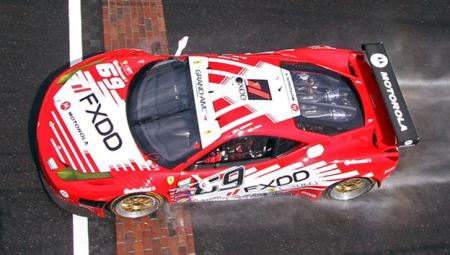Rain tossed competitors curveballs at the Indianapolis Motor Speedway and it’s possible weather could be a factor next week as well when the GRAND-AM Rolex Sports Car Series returns to Watkins Glen International. GRAND-AM runs its races rain or shine – at least to a point. Example: At Indianapolis, the Brickyard Grand Prix was started under caution due to standing water on the track. Full-out competition began when the asphalt began to dry.
For that reason, teams don’t make major changes for wet conditions, knowing that ultimately the event will be completed under normal circumstances.
“We don’t commit to doing a full (wet) set-up. Mostly, we just change (to rain tires) and go,” said Brian Pillar, engineer for the DP No. 10 Wayne Taylor Racing Corvette DP. “Generally when it rains the race goes yellow and you follow the pace car. Any compromise really hurts you when it dries out. You can change aero pieces which we can undo if the weather clears up.”
Pillar is complimentary of Continental’s wet track tire. “They’ve been very good and they move a lot of water. And they last a really long time.”
Teams rarely, if ever, test when the track is wet, complicating the decision when to switch back to a normal “slick”-type tire.
“The strategy of when to switch tires at Indy was further complicated by the fact that the track dried out on the oval more than in the infield section,” said Ian Willis, head engineer and co-owner of the GT-leading No. 69 AIM Autosport Team FXDD with Ferrari. “If we had the opportunity to test under these conditions, like the first time the track dried out, we would have determined a target lap time to reach when it is quicker to run dry tires.
“If we haven’t tested, it really comes down to the driver and engineer communicating as to when the driver feels that the track is dry enough that they can go faster on slick tires.”
Wayne Taylor Racing’s Ricky Taylor believes driving on a damp track – whether on wet tires or slicks – is the most demanding challenge a driver faces. “Rain is the most mentally-draining thing we do,” said Taylor. “It’s exhausting.”
When the track is dry, the racing line is obvious: Follow the rubber for maximum grip. “The rubber is very slippery when it’s wet so you have to drive off-line,” said Taylor. “There is very little grip and it’s easy to lose (control of) the car and make mistakes.
“I can say it’s a lot of work.”
Fonte:http://www.grand-am.com


